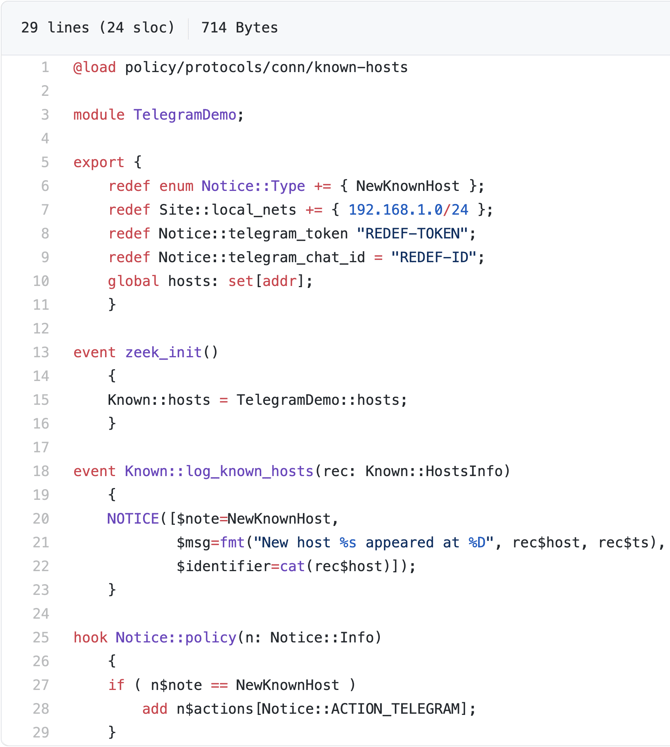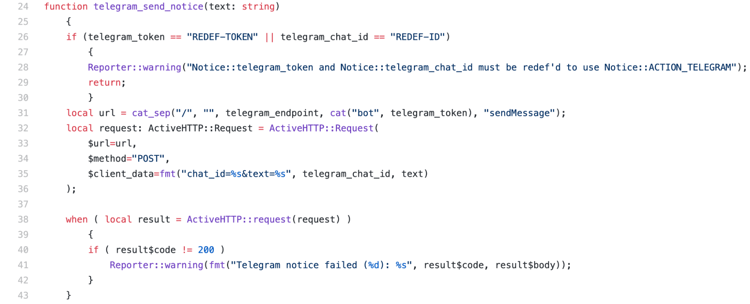A network engineer in a Zeek Week world
I’m seven months into a new job here at Corelight as a product manager, and I’m still as excited about Zeek as I was last month about Zeek Week....
Zeek’s Notice Framework enables network operators to specify how potentially interesting network findings can be reported. This decoupling of detection and reporting highlights Zeek’s flexibility: a notice-worthy event in network A may be run-of-the-mill in network B. Much like detections, reporting needs will likely differ between networks as well. Out of the box, Zeek includes eight actions that can be taken when a notice is generated: four send emails, one generates an entry in the notice.log, one is a no-op, one drops an address based on NetControl policy, and one adds metadata to the Notice::Info record. A good start, but I must admit the email-heavy focus feels very 1990s.
Beyond being a tad passé, I realized a more technical shortcoming when trying to send notices about my home network to my phone: most residential ISPs block outgoing SMTP traffic to curb spam. Thankfully, we can easily define new Notice::Actions to get around that pesky filtering done by ISPs. I’ve created and released a Zeek package, zeek-notice-telegram, that sends a message to a user or group chat on Telegram when the new action is added to a notice. The README on GitHub explains how to set it up. I’ll walk you through a simple example that uses the package as well as the package itself so you can write your own action.
zeek-notice-telegramMy home network is small and I’m a paranoid security professional, so naturally I run Corelight@Home. I mostly analyze the logs after the fact, but I’d like to do more real time monitoring. My first thought was to be notified on my phone when new hosts join my network. The existing known hosts policy script more or less does this. If enabled, it generates a log of all hosts that completed a TCP handshake successfully. By default, it resets the set of known hosts after 24 hours. This makes sense for a large enterprise where storing all this data in memory could cause problems. But for my small home network that maxes out at 256 hosts, I will disable this resetting behavior. Now known hosts will be logged when a never-before-seen IP address is used on my network. But how can I integrate notices and Telegram to an existing policy script?
At a high-level, the steps I will take are: (1) enable the known hosts policy script, (2) redefine some variables from the Known:: namespace to fit our new use case, (3) generate a notice when a known host would be logged by the system, and (4) add our new action to the notice so a message is sent directly to me over Telegram. Below is the full content of telegram-demo.zeek, which is also available in the repository:

zeek-notice-telegram package.Since the example is short, let’s walk through each line of the code. Line 1 loads the known hosts policy script, which exposes the events we will use (step 1). Line 3 defines the module’s namespace. The export block on lines 5--11 redefines a new notice type (line 6), the local CIDR block I use at home (line 7), as well as the two Telegram-specific values that identify my bot’s token (line 8) and my user ID (line 9), respectively. These last two have been redacted. In order to run this demo on your network, you will need to substitute your values for these variables. See the configuration section of the README for more detail.
Lines 10 and 13--16 correspond to step 2. Line 10 defines a new set for the hosts. Note that unlike the analogous line in known_hosts.zeek, ours does not have the &create_expire attribute. In line 15, we replace the hosts set used in the known hosts policy script, with the one we defined on line 10. With this change, it will track hosts for as long as Zeek is running. In the current implementation, this will not track hosts across restarts of Zeek. This can be addressed by changing the Broker::BackendType to anything except for Broker::MEMORY and is left as an exercise for the reader.
The rest of the script is one event (lines 18--23; step 3) and one hook (lines 25--29; step 4): the log_known_hosts event fires when a newly observed host is about to be logged to the known_hosts.log. The Notice::policy hook allows us to update a notice before it is forwarded to the actions assigned to it. In the event in step 3, we generate a notice with our newly defined NewKnownHost Notice::Type. In the hook in step 4, we add the Telegram action to any notices that have the note type of NewKnownHost. Without this guard, all notices would be sent over Telegram.
Be aware that ACTION_TELEGRAM could be added directly when calling the NOTICE function by including it in the actions field. However, this tightly couples the detection event with the reporting action, which one shouldn’t do. Sending a message for every new host on my small home network will be tolerable, but on a university network with tens of thousands of students it would be completely unsustainable. The idiomatic way to do this in Zeek is to use the Notice::policy hook as I did above. This allows network operators to better suit my code to their use cases.
Here’s a video of the notices I received on my phone over Telegram when I ran the following Zeek command on a PCAP collected from my home network: $ zeek -Cr ~/test.pcap zeek-notice-telegram telegram-demo.zeek
If you pay close attention, you’ll notice the timestamps of the events show much longer gaps in time than we see based on the message inter-arrival times. Since we’re reading from a PCAP, Zeek is processing the packets faster than in real time. If this were running on my Zeek instance at home, I would have received these messages over approximately seven hours.
Venerable reader, now you know how to use my extension to send notices over Telegram. But what if this doesn’t fit your use case and you need to send notices over a different media? Fear not, I will now walk you through the zeek-notice-telegram package itself to prepare you to write your very own extension to the Notice Framework.
The code for telegram.zeek is a bit longer, so I won’t do a line-by-line walkthrough, but conceptually you can write your own messaging notice action with the following four steps:
I recommend relying on messaging technology that has an HTTP API for delivery. Zeek has a built-in way to make HTTP requests and HTTP is unlikely to be blocked by other network administrators, unlike what we saw earlier with SMTP.
First, we redefine the Action enum to have our new action:

Note that we are doing our work in the Notice namespace, since we are extending that module.
Second, we add a hook so notices that contain our new action will run our messaging code:

When our package is loaded, every notice that is raised in other parts of the system will first run this hook. The hook checks for the presence of our action, and runs two functions to format the payload of our message and send the message over Telegram.
Third, the function telegram_payload takes a Notice::Info record and returns a string representing the text of the message. The text will always contain the notice type and notice message fields from the record, and optionally includes the sub-message, connection details, and source if present. Many fields in a Notice::Info record are marked &optional, so use the ?$ operator to check to see if they’re defined before including them.
Fourth, we send the message over Telegram using the HTTP API:

Lines 26--30 check to see if either of the Telegram-specific variables have not been redefined, and if so, outputs a warning and returns early so we do not needlessly use Telegram’s API with a request that will fail. Lines 31--36 construct the request using Zeek’s ActiveHTTP module. These will be specific to whichever service you rely on to deliver your messages. Lines 38--42 perform the API request, and output an error if it does not return successfully.
That’s all there is to extending the Notice Framework. And one more thing: your action doesn’t need to be limited to sending a message. For example, it could add useful metadata or drop future connections to an offending host. The possibilities are limited only by your imagination.
Even as an intermediate Zeekscript programmer, I was surprised at not only how simple it was to add a new notice action but how little code was needed to use the new action for a non-trivial application. This demonstrates the flexibility of Zeek and how it can be leveraged for quality of life improvements without much programming. If the zeek-notice-telegram package tickled your fancy, you may also want to check out the zeek-notice-slack package that does the same thing but over Slack. Let us know about your Notice Framework extensions and happy hunting!
By Yacin Nadji, Corelight Security Researcher
I’m seven months into a new job here at Corelight as a product manager, and I’m still as excited about Zeek as I was last month about Zeek Week....
In this article we'll share some useful guidance for writing a real-world Zeek package in JavaScript or TypeScript.
I’m Amber Graner, and I’m excited to join Corelight, Inc as the Director of Community for the open source Zeek project.